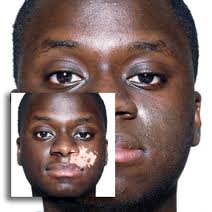What is Vitiligo?
Vitiligo is a disease of skin pigments called melanin. Rather, it is a disease where there is a loss of skin pigment or color. Vitiligo affects about 2% of world population and close to 8% of Indian and Mexican populations. Vitiligo is not a serious disease, medically speaking. It’s social significance is more than medical importance, as it does not cause any major harm to the body.

In simple words, vitiligo is caused by one or two of the following processes:
- Melanin cell destruction, leading to loss of color on skin
- Defective process of melanin formation, hence, no skin color formation
There is no exact cause known for the above processes. There are some theories which are considered responsible for the above processes in vitiligo. In brief, genetic and immunological factors are considered responsible for vitiligo.
Due to destruction of the melanin (pigment) cells due to lesser known processes (largely what is called as an auto-immune disorder) the normal skin starts loosing pigments from various parts of the skin, in a varying speed and extent. The indication of strong genetic factor is observed in the form of family history of one or more of the auto-immune diseases such as vitiligo, alopecia areata, diabetes, under active thyroid, , cancer, rheumatoid arthritis or allergies.
Symptoms and spread of Vitiligo
The typical appearance of Vitiligo is a milky white de-pigmented spot or spots. It may vary from a single white spot to multiple spots. The shape too is a variable. In some cases generalized de-pigmentation observed all over the body. It has a tendency to start as a single spot and gradually grow in size and number. It may present with a single or several spots on limbs or abdomen or back and then spreading to other parts of the body.
Some cases showing affection of the mucocutaneous junctions such as finger-tips, corners of the mouth, private parts, around eyes. The spread of the disorder is usually slow and progressive. Symmetrical appearance on both the sides of the body (say, on the legs, hands, etc.) is common. In rare cases one finds vitiligo spreading all over the body.
Spread of vitiligo:
The spread of vitiligo is governed by various factors such as 1. Genetic activity 2. Hormonal factors 3. Continued Stress factors 4. Exposure to chemicals, etc. Many patients may start with just a single spot and may not get more spots for many years or for throughout life time. Some patients may show rapid spread, as fast as from one spot to hundreds, in a few months time. It is not possible to predict the pace of spread. Also, some patients may show intermittent spread. It may be noted form experience that those who pace certain body areas affected such a finger tips, are at higher risk of having an aggressive spread; it is not a rule though. Some patients may present with grey hair, suggesting loss of pigment in the hair.
Associated Systemic Disorders:
There are several systemic diseases (affecting the entire body system), which are at times associated with Vitiligo:
- Under active thyroid
- Diabetes
- Alopecia Areata
- SLE (Systemic Lupus Erythematosus)
- Pernicious Anemia
- Addison’s Disease
- Collagen Diseases
- Grave’s Disease
It may be noted that the sufferers of Vitiligo need not be unduly scared of the above disease conditions, as they should not be regarded as the complications of Vitiligo in every case.
What does the treatment do?
The scientific and documented study shows that the homeopathic vitiligo treatment helps achieve:
- Enhances melanocyte formation by stimulating the natural process called melanogenesis
- Controls genetic disposition by using miasmatic medicines
- Treats after effects of environmental factors such as exposure to chemicals
- Treats aftereffects of emotional stress which may have triggered the disease process of vitiligo
- Corrects the hormonal imbalance such as Under active thyroid (hypothyroid)
- Helps body cope up with stress and emotional pressures
- Individualistic approach whereby every patient is treated based on one’s case
What is the duration of treatment for Vitiligo :
Vitiligo is an obstinate, difficult disease which is largely considered incurable. The duration of vitiligo treatment depends on the following parameters;
- Extent of vitiligo: Fewer spots respond faster and better than larger number of sports
- Size of sports: Smaller spots respond better than larger spots. Very large spots may not respond
- Vitiligo spots on one side of the body respond better than those on identically other side (Bilateral Symmetrical).
- Spots on the finger tips, lips, corner of the mouth, etc. do not respond. This can be controlled if treatment is taken for long time.
Most patients show improvement within initial four months, in form of re-pigmentation or slowing down of spread of vitiligo. Vitiligo cure success varies from patient to patient.
Click on the below link to know more about vitiligo management @ Sattvam:
http://www.youtube.com/watch?v=j61U6G8J42U





